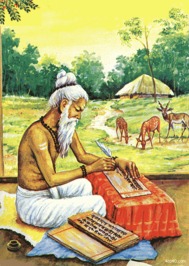Moreover, we should know about the details of drama which is said in AiÉnydpR[m! that k{Qen AalMbyet! gIt< hStenaw¡ àdzRyet!,
c]u_ya¡ dzRyet! Éav< pada_ya< talmacret!.
The song should be sustained by the throat, the ideas to be shown by the hands, the feelings by the eyes and the rhythm to be kept by the feet.
Here it is to be added that ytae hStSttae †iò> ytae †iòSttae mn>,
ytae mnSttae Éav> ytae ÉavSttae rs>.
Where the hand is there follows the eyes; where the eyes goes, there the mind follows; where the minds there, the Bhava and where Bhava the sentiment follows.
Éas> was a great and renowned Dramatist or play-write of Ancient India. His plays were very popular even in the days of kaildas>, kaildas> has bestowed the high praise on kaildas thus “àiwtyzsa< ÉassaEimLlkivpuÇadIna<” in his malivkai¶imÇm!, É”ba[> praised Éas> thus sUÇxark&tarMÉE> naqkEbRhuÉUimkE,
spatkEyRzae leÉe Éasae devkulEirv. in his h;Rcirtm!, The merit of the works of Éas was highly appreciated by rajzeor thus,
Éasnaqkc³e=iSmn! DekE> i]Pte prIi]tum!,
SvPnvasvdÄSy dahkae=ÉUÚ pavk>.
kivrajjydev> appreciates Éas in his book àsÚra"vm! thus - “Éasae has>”
If the Kavya is personified as a lady, one can treat Éas as the smile of Kavya.
Éas ‘s contemporarians are known by the phrase of kaildas as above mentioned. They were saEim‘k and kivpuÇ, Éas> is the author of 13 plays
which are traced by Mahamahopadhyaya T. Ganapati Sastri. Moreover, he published all these plays. Among those 13 plays, SvßvasvdÄm! , àit}a-yaEgNxray[m! and Aivmarkm! are based on the themes of b&hTkwa,
Éas> has composed two dramas àitmanaqkm! and AiÉ;eknaqkm! based on the story oframay[m!, With the plot of mhaÉartm! , Éas has produced six dramas. They are dUtvaKym! ,dUt"qaeTkcm! , mXymVyayaeg>, k[RÉarm! , ^éɼm!
and pÂraÇm!, Only one drama is based on the plot of Éagvtm!
is balcirÇm!.
Actually speaking, being a stage-manager and play-write, Éas> would
have been composed many plays. There is a dispute on the play
y})lm! among the scholars to accept as well as to reject.
to be continued.,




